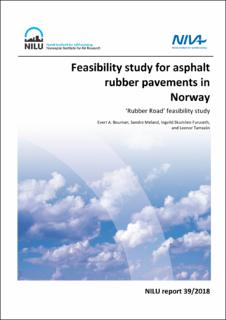| dc.contributor.author | Bouman, Evert | |
| dc.contributor.author | Meland, Sondre | |
| dc.contributor.author | Furuseth, Ingvild Skumlien | |
| dc.contributor.author | Tarrasón, Leonor | |
| dc.date.accessioned | 2020-10-14T07:33:25Z | |
| dc.date.available | 2020-10-14T07:33:25Z | |
| dc.date.created | 2020-10-13T14:45:55Z | |
| dc.date.issued | 2020 | |
| dc.identifier.isbn | 978-82-425-3016-5 | |
| dc.identifier.issn | 2464-3327 | |
| dc.identifier.uri | https://hdl.handle.net/11250/2682588 | |
| dc.description.abstract | RubberRoad proposes to use rubber from used tires in the production of asphalt for road and bicycle ways. This recycling approach has not gained much attention in Norway despite its apparent advantages, such as noise reduction, increased durability, safer shock impact, and reduced climate and environmental impacts. The Life Cycle Analysis carried out during this project feasibility study has demonstrated a series of environmental benefits in the use of rubber in asphalt production. It has also helped identify relevant knowledge gaps related to the use phase of the rubberized asphalt and its impact to noise, air and micro-plastic pollution. Better understanding of these effects would probably result in even larger environmental benefits of rubberized asphalt with respect to standard asphalt production. However, while the tire recycling industry is generally positive to the disposal of used tires in asphalt production, additional incentives need to be put in place for the Norwegian asphalt producers to consider actively contributing to this development. | en_US |
| dc.description.abstract | RubberRoad foreslår å bruke gummi fra brukte bildekk i asfaltproduksjon til bil- og sykkelveier. Denne resirkuleringsmetoden er ikke særlig kjent i Norge, til tross for påviste fordeler som blant annet støyreduksjon, økt holdbarhet, støtdemping ved ulykker samt redusert klima- og miljøpåvirkning. Livssyklusanalysen, som ble utført i løpet av dette prosjektets gjennomførbarhetsstudie, har vist en rekke miljøfordeler ved bruk av gummi i asfaltproduksjon. Den har også bidratt til å identifisere kunnskapshull relatert spesielt til bruken av gummiasfalten og dens innvirkning på støy, luft og mikro-plastforurensning. Bedre forståelse av disse effektene vil trolig føre til enda større miljøfordeler av gummiasfalt i forhold til standard asfaltproduksjon. Imidlertid, mens dekkgjenvinningsindustrien generelt er positiv til bruk av brukte dekk i asfaltproduksjon, må det legges til rette for ytterligere incitamenter for at norske asfaltprodusenter skal vurdere å bidra aktivt til denne utviklingen. | nb_no |
| dc.language.iso | eng | en_US |
| dc.publisher | NILU | en_US |
| dc.relation.ispartofseries | NILU report;38/2018 | |
| dc.subject | Bildekk | en_US |
| dc.subject | Bildekk | nb_no |
| dc.subject | Sirkulær økonomi | nb_no |
| dc.subject | Circular economy | en_US |
| dc.subject | Asfalt | nb_no |
| dc.subject | Asphalt | en_US |
| dc.title | Feasibility study for asphalt rubber pavements in Norway. ‘Rubber Road’ feasibility study. | en_US |
| dc.title.alternative | RubberRoad – Brukte dekk i asfaltproduksjon | nb_no |
| dc.type | Research report | en_US |
| dc.description.version | publishedVersion | en_US |
| dc.rights.holder | © NILU – Norwegian Institute for Air Research | en_US |
| dc.source.pagenumber | 39 | en_US |
| dc.source.issue | 39/2018 | en_US |
| dc.identifier.cristin | 1839245 | |
| dc.relation.project | NILU - Norsk institutt for luftforskning: 118097 | en_US |
| dc.relation.project | Norges forskningsråd: 290305 | en_US |
| cristin.ispublished | true | |
| cristin.fulltext | original | |
